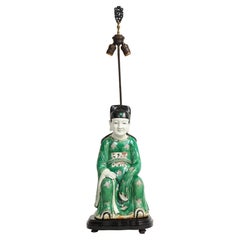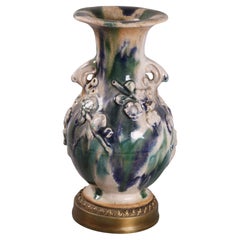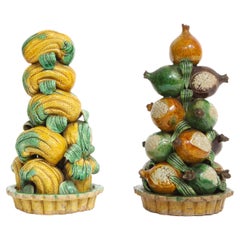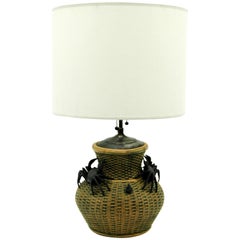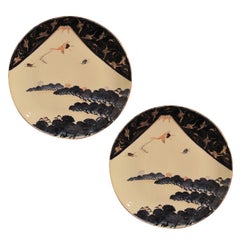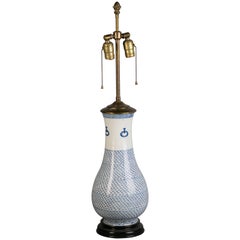Manhattan - Ceramics
to
15
1,918
1,365
122
2
3
2
1
1
1
1
15
49
58
2
25
11
12
4
1
1
1
2
1
116
85
20
9
6
110
99
74
24
10
124
124
124
1
1
1
1
1
Item Ships From: Manhattan
19th C. Chinese Famille Vert Porcelain Figure of a Seated Scholar as a Lamp
Located in New York, NY
A fabulous 19th century Chinese Famille Vert Porcelain figure of a seated scholar mounted as a lamp. Beautifully hand-painted with an array of monochrom...
Category
19th Century Chinese Qing Antique Manhattan - Ceramics
Materials
Porcelain
Chinese sancai ceramic vase, 19th c.
Located in New York, NY
the base that is shown in the pictures is not included with this vase; 6in(D) x 6in(W) x 11in(H) are the dimensions of the vase without the base
Category
Late 19th Century Chinese Antique Manhattan - Ceramics
Materials
Ceramic
Two Chinese Kangxi '18th C.' Porcelain Fruit Stands, Buddhas Hand & Pomegranates
Located in New York, NY
Two fantastic and rare Chinese Kangxi Period porcelain fruit stands, Representing Buddhas Hand & Pomegranates. Each of these is beautifully hand-...
Category
1710s Chinese Chinese Export Antique Manhattan - Ceramics
Materials
Porcelain
Asian Clay Vase Table Lamp
Located in NYC, NY
An original Asian clay container made into a table lamp. The vase has a basket weave motif throughout and has two big black crabs and a small black conch as ornaments. There is an un...
Category
Mid-20th Century Chinese Anglo-Japanese Manhattan - Ceramics
Materials
Clay
Pair of Imari Chargers
Located in Montreal, QC
Pair of Japanese Imari chargers showing cranes and Mount Fuji.
Category
19th Century Japanese Antique Manhattan - Ceramics
Materials
Ceramic
Chinese Blue and White Vase Mounted as Lamp, Kang Hsi, circa 1720
Located in New York, NY
Chinese blue and white vase mounted as lamp, Kang Hsi, circa 1720.
Category
1720s Chinese Antique Manhattan - Ceramics
Materials
Porcelain
A Highly Rare Pair of Monumental Qing Dynasty Rouleau Porcelain "Dragon" Vases
Located in New York, NY
A Highly Rare Pair of Monumental Qing Dynasty Rouleau Porcelain "Dragon" Vases
A Masterful Display of 19th Century Chinese Artistry:
The mid-19th century Qing Dynasty marked a period of artistic innovation and imperial grandeur, as exemplified by this rare and monumental pair of Rouleau vases. These exceptional porcelain works, notable for their commanding size and vibrant palette, are a testament to the unparalleled craftsmanship that flourished during this era. Embellished with a dynamic tableau of dragons rendered in bold hues of red, green, blue, brown, and yellow, these vases embody both artistic brilliance and the deep cultural symbolism woven into Chinese decorative arts.
Artistic Excellence and Symbolism:
At the heart of these magnificent vases lies a visual narrative that channels the power and mystique of the dragon, a central motif in Chinese culture symbolizing imperial authority, strength, and cosmic energy. The intricate depiction of dragons in motion, intertwined amidst stylized ocean waves, conveys a sense of fluidity and dynamic movement. Each color used—the crimson reds, verdant greens, striking blues, earthy browns, and golden yellows—has been meticulously applied, reflecting a mastery of the high-fired, polychrome enameling techniques perfected during the Qing Dynasty.
The Rouleau form, with its cylindrical body, short neck, and slightly flared mouth, was a favored shape for large-scale vases in the 18th and 19th centuries. The form’s structured elegance allowed for expansive decorative panels, serving as an ideal canvas for intricate, multi-layered designs. This pair demonstrates how artisans skillfully balanced the flowing movement of the dragons with the rhythmic motifs of waves, resulting in a harmonious composition that engages the viewer from every angle.
Craftsmanship and Technique:
These vases represent the pinnacle of porcelain artistry achieved under the Qing Dynasty, showcasing techniques that reflect centuries of refined craftsmanship. The precision in the application of overglaze enamels and the expert manipulation of kiln temperatures to achieve vibrant and consistent coloration are indicative of the expertise within the imperial kilns. The dragons' scales, rendered with remarkable detail, create a textured effect that contrasts beautifully with the smooth, undulating waves, enhancing the three-dimensional quality of the design.
The depth of color and the crisp delineation of each element point to a rigorous and time-intensive process. These qualities signify the involvement of highly skilled artisans who adhered to the imperial standards set by the royal court, ensuring that each piece was a fitting representation of the empire’s wealth and cultural prowess.
Historical and Cultural Significance:
Vases of this caliber were not merely decorative; they were imbued with profound symbolic meaning and often commissioned for imperial use or gifted as prestigious diplomatic offerings. The dragon motif, deeply embedded in Chinese folklore and philosophy, was associated with the emperor himself—known as the "Son of Heaven"—and symbolized his divine right to rule. These vases also reflect the Qing Dynasty's flourishing export trade and the global fascination with Chinese porcelain during the 19th century. European collectors and royal patrons prized such pieces for their artistry and the exoticism they represented, contributing to a legacy that elevated Chinese porcelain to a revered status in the annals of decorative art history.
Provenance and Collectability:
The extraordinary scale, exceptional craftsmanship, and rarity of this pair establish them as museum-quality works. Such vases would have held a place of honor in a palace or wealthy estate, reflecting not only the owner’s status but also an appreciation for the profound cultural and artistic traditions of China. Their provenance—potentially tied to an imperial commission or significant historical collection—underscores their importance as objects of study and admiration.
Provenance:
Private American Collection, acquired in London, circa 1905.
Thence by descent to the current owners
Solomon Treasure...
Category
Mid-19th Century Chinese Qing Antique Manhattan - Ceramics
Materials
Porcelain
Atelier Saigon, Pair of Large Urns with Rope and Hoof Base Motifs, Vietnam
By Atelier Saigon 1
Located in New York, NY
Born of the collaboration between a Parisian antiques dealer and a rural Vietnamese artists' community, these impressive monumental urns are a testam...
Category
2010s Vietnamese Manhattan - Ceramics
Materials
Steel
